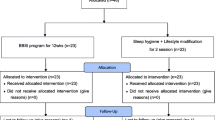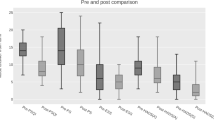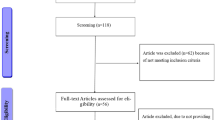Abstract
Introduction and hypothesis
The objective was to check the effects of two nonpharmacological treatments on the sleep quality of women with nocturia.
Methods
A randomized controlled clinical trial in which 40 women with nocturia were randomized into two groups; one was subjected to tibial nerve stimulation (GTNS) and the other received pelvic floor muscle training associated with behavioral therapy (GPFMT). Both groups were followed for 12 weeks, with one session/week; evaluated by the Pittsburgh Sleep Quality Index (PSQI), King’s Heath Questionnaire (KHQ), and Epworth Sleepiness Scale (ESS). The Wilcoxon test was used to compare intra-group data and the Mann–Whitney test for intergroup results. Effect size and confidence interval were calculated, and the level of significance was set at 5%.
Results
Both groups showed improvements in quality of sleep, observed by the PSQI total score (GTNS from 9 ± 0.88 to 7 ± 0.94, p = 0.002; GPFMT from 8 ± 0.80 to 5 ± 0.94, p < 0.001) and the sleep/energy domain of the KHQ (GTNS from 66.66 ± 9.03 to 16.66 ± 7.20, p = 0.002; GPFMT from 66.66 ± 9.30 to 0.00 ± 7.26, p = 0.001).
Conclusions
Both nonpharmacological treatments proposed (TNS or PFMT) were equally able to improve quality of sleep of women with nocturia.

Similar content being viewed by others
References
Abrams P, Cardozo L, Fall M, Griffiths D, Rosier P, Ulmsten U, et al. The standardisation of terminology in lower urinary tract function: report from the standardisation sub-committee of the international continence society. Urology. 2003;61(1):37–49.
Pesonen JS, Cartwright R, Mangera A, Santti H, Griebling TL, Pryalukhin AE, et al. Incidence and remission of Nocturia: a systematic review and meta-analysis. Eur Urol. 2016;70(2):372–81.
Weiss JP, Blaivas JG, Blanker MH, Bliwise DL, Dmochowski RR, Drake M, et al. The New England research institutes, Inc. (NERI) Nocturia advisory conference 2012: focus on outcomes of therapy. BJU Int. 2013;111(5):700–16.
Terauchi M, Hirose A, Akiyoshi M, Owa Y, Kato K, Kubota T. Prevalence and predictors of storage lower urinary tract symptoms in perimenopausal and postmenopausal women attending a menopause clinic. Menopause. 2015;22(10):1084–90.
Madhu C, Coyne K, Hashim H, Chapple C, Milsom I, Kopp Z. Nocturia: risk factors and associated comorbidities; findings from the EpiLUTS study. Int J Clin Pract. 2015;69(12):1508–16.
Bosch JLHR, Weiss JP. The prevalence and causes of nocturia. J Urol. 2010 Aug;184(2):440–6.
Burgio KL. Update on behavioral and physical therapies for incontinence and overactive bladder: the role of pelvic floor muscle training. Curr Urol Rep. 2013;14(5):457–64.
Iimura K, Watanabe N, Masunaga K, Miyazaki S, Hotta H, Kim H, et al. Effects of a gentle, self-administered stimulation of perineal skin for nocturia in elderly women: a randomized, placebo-controlled, double-blind crossover trial. PLoS One. 2016;11(3):e0151726.
Van Balken MR, Vandoninck V, Gisolf KW, Vergunst H, Kiemeney LA, Debruyne FM, et al. Posterior tibial nerve stimulation as neuromodulative treatment of lower urinary tract dysfunction. J Urol. 2001;166(3):914–8.
Doo SW, Lee HJ, Ahn J, Kim JH, Yun JH, Yang WJ, et al. Strong impact of nocturia on sleep quality in patients with lower urinary tract symptoms. World J Mens Health. 2012;30(2):123.
Bertolazi AN, Fagondes SC, Hoff LS, Dartora EG, da Silva Miozzo IC, de Barba MEF, et al. Validation of the Brazilian Portuguese version of the Pittsburgh sleep quality index. Sleep Med. 2011;12(1):70–5.
Kelleher CJ, Cardozo LD, Khullar V, Salvatore S. A new questionnaire to assess the quality of life of urinary incontinent women. Br J Obstet Gynaecol. 1997;104(12):1374–9.
Tamanini JTN, D’Ancona CAL, Botega NJ, Rodrigues NN. Validation of the Portuguese version of the King’s health questionnaire for urinary incontinent women. Rev Saude Publica. 2003;37(2):203–11.
Kelleher CJ, Pleil AM, Reese PR, Burgess SM, Brodish PH. How much is enough and who says so?. BJOG. 2004;111(6):605–12.
Johns MW. A new method for measuring daytime sleepiness: the Epworth sleepiness scale. Sleep. 1991;14(6):540–5.
Bertolazi AN, Fagondes SC, Hoff LS, Pedro VD, Menna Barreto SS, Johns MW. Portuguese-language version of the Epworth sleepiness scale: validation for use in Brazil. J Bras Pneumol. 2009;35(9):877–83.
Laycock J, Jerwood D. Pelvic floor muscle assessment: the PERFECT scheme. Physiotherapy. 2001;87(12):631–42.
Ferreira CHJ, Barbosa PB, de Oliveira Souza F, Antônio FI, Franco MM, Bø K. Inter-rater reliability study of the modified Oxford grading scale and the Peritron manometer. Physiotherapy. 2011;97(2):132–8.
Bo K, Talseth T, Holme I. Single blind, randomised controlled trial of pelvic floor exercises, electrical stimulation, vaginal cones, and no treatment in management of genuine stress incontinence in women. BMJ. 1999;318(7182):487–93.
Staskin DR, Peters KM, MacDiarmid S, Shore N, de Groat WC. Percutaneous tibial nerve stimulation: a clinically and cost effective addition to the overactive bladder algorithm of care. Curr Urol Rep. 2012;13(5):327–34.
Schreiner L, dos Santos TG, Knorst MR, da Silva Filho IG. Randomized trial of transcutaneous tibial nerve stimulation to treat urge urinary incontinence in older women. Int Urogynecol J. 2010;21(9):1065–70.
Tran K, Levin RM, Mousa SA. Behavioral intervention versus pharmacotherapy or their combinations in the management of overactive bladder dysfunction. Adv Urol. 2009;2009:1–10.
Mesquita LA, César PM, De Monteiro MVC, da Silva Filho AL. Terapia comportamental na abordagem primária da hiperatividade do detrusor. Femina. 2010;38(1).
Urdan TC. Statistics in plain English. Taylor & Francis Group: Routledge; 2011. 211 p.
Olivera CK, Meriwether K, El-Nashar S, Grimes CL, Chen CCG, Orejuela F, et al. Nonantimuscarinic treatment for overactive bladder: a systematic review. Am J Obstet Gynecol. 2016;215(1):34–57.
Tai C, Chen M, Shen B, Wang J, Roppolo JR, de Groat WC. Irritation induced bladder overactivity is suppressed by tibial nerve stimulation in cats. J Urol. 2011;186(1):326–30.
Shimizu N, Nagai Y, Yamamoto Y, Minami T, Hayashi T, Tsuji H, et al. Survey on lower urinary tract symptoms and sleep disorders in patients treated at urology departments. Nat Sci Sleep. 2013;5:7–13.
Bower WF, Whishaw DM, Khan F. Nocturia as a marker of poor health: causal associations to inform care. Neurourol Urodyn. 2017;36(3):697–705.
Brunner A, Riss P. Nocturia in women. Maturitas. 2011;70(1):16–21.
Suekane S, Ueda K, Suyama S, Hayashi T, Toyozawa N, Yoshitake M, et al. Comprehensive health-related quality of life is influenced by nocturia and sleep disturbance: investigation based on the SF-8. Kurume Med J. 2015;62(1.2):9–16.
Tam Y-Y, Wu C-C, Hsu H-S, Chang S-C, Wang H-H, Chuang H-C, et al. The effect of nocturia on sleep quality and daytime function in patients with lower urinary tract symptoms: a cross-sectional study. Clin Interv Aging. 2016;11:879–85.
Buysse DJ, Reynolds CF, Monk TH, Berman SR, Kupfer DJ. The Pittsburgh sleep quality index: a new instrument for psychiatric practice and research. Psychiatry Res. 1989;28(2):193–213.
Buysse DJ, Hall ML, Strollo PJ, Kamarck TW, Owens J, Lee L, et al. Relationships between the Pittsburgh sleep quality index (PSQI), Epworth sleepiness scale (ESS), and clinical/polysomnographic measures in a community sample. J Clin Sleep Med. 2008;4(6):563–71.
Hsiao S-M, Chang T-C, Chen C-H, Wu W-Y, Lin H-H. Frequent nocturia episodes, a suboptimal response to treatment, and small bladder capacity predict the need for persistent antimuscarinic therapy or re-treatment after discontinuation of antimuscarinics in female overactive bladder. Menopause. 2017;24(1):100–4.
Funding
Financial support by the São Paulo Research Foundation (FAPESP, grant number 2013/06412–9).
Author information
Authors and Affiliations
Corresponding author
Ethics declarations
Conflicts of interest
The authors declare that they have no conflicts of interest.
Rights and permissions
About this article
Cite this article
Furtado-Albanezi, D., Jürgensen, S.P., Avila, M.A. et al. Effects of two nonpharmacological treatments on the sleep quality of women with nocturia: a randomized controlled clinical trial. Int Urogynecol J 30, 279–286 (2019). https://doi.org/10.1007/s00192-018-3584-8
Received:
Accepted:
Published:
Issue Date:
DOI: https://doi.org/10.1007/s00192-018-3584-8




